 Research Article
Research Article
The Fight Against Opioids Epidemic: Americans’ Views on Community Involvement.
Ami R Moore1*, Joshua Castleberry2, Skyla Kraal1 and Foster Amey3
1Department of Rehabilitation and Health Services, University of North Texas, USA
2Kent State University, USA
3Department of Sociology and Anthropology, Middle Tennessee State University, USA
Ami R. Moore, Department of Rehabilitation and Health Services, University of North Texas, USA
Received Date:February 16, 2024; Published Date:February 26, 2024
Abstract
The opioid epidemic has affected Americans of all ages, social classes, and communities. Many different policies and programs have been implemented in the past with the overarching goal of minimizing the destructive impact of the opioid crisis. This paper examines factors that determine Americans’ views on how their communities have been involved in the fight against the opioid epidemic, controlling for the perceived levels of substance use in the community, political affiliations, and demographic factors. Data came from an AP-NORC poll (Pharmaceutical companies and drug users most often blamed for opioid crisis) conducted in April 2019. Results show the complexity and the multifaceted nature of the opioid crisis. Binary logistic analysis was used. While different factors significantly explain the assessments of community members, depending on the policy being used, some factors consistently significantly explain their views regardless of the policy. Overall, results indicate that different opinions are shared depending on Americans’ political, residential, and social characteristics as well as the community exposure to substance use. Several policy recommendations are made. This study adds to the body of literature on the opioid crisis and communities’ assessment of what has been done to help stop the crisis.
Keywords: Opioid epidemic; community assessment; political and socidemographic factors; American views
Introduction
The opioid epidemic has affected Americans of all ages, social classes, and communities. There were 68,630 opioid-associated overdose deaths in 2020 [1] and over 841,000 opioid-related total deaths since 1999 [2]. The effects of these numbers are profound, considering that opioid overdose deaths have been one of the leading causes of unintentional deaths since 2012 (Centers for Disease Control, 2020). In addition, the mortality rate is greater for misuse of opioids than that of car accidents (United Nations Office on Drugs and Crime [UNOCD], 2017). The steady increase in overdose deaths and decrease in life expectancy have brought attention to much-needed comprehensive public health approaches and the establishment of infrastructure to assuage its continued growth [3].
Many different policies and programs have been implemented in the past with the overarching goal of minimizing the destructive impact of the opioid crisis. Also, research on public health initiatives to fight against the growing opioid epidemic has become increasingly complex, with recent work more closely examining the key roles of social determinants, laws, and policy [4-6]. This paper examined factors that determine Americans’ assessment of their community involvement in the fight against the opioid crisis.
Essential for ensuring any policy or intervention, community involvement has been shown as a significant contributor to their successful implementation and sustainability [7]. Community engagement approaches have specifically been shown to be impactful in many areas of public health intervention and policy [8]. Community involvement relies on participation and buy-in from the communities in which it is being conducted [9], eliciting a community’s strengths and autonomy [10]. Additionally, intervention and policy processes that have increased community involvement and collaboration can potentially decrease stigmatization and optimize community resources for a collective response to the opioid epidemic [11, 12].
Understanding Americans’ views on their community engagement in fighting the opioid epidemic is vital for several reasons. First, public opinion has been shown to influence public policy decisions [7,13] and have direct and indirect effects on funding programs that address problems that the public deems important to fix [14]. Second, public opinion often influences political agendas at both the local and state levels [15]. Lastly, there is a lack of consensus on how to address the opioid epidemic; as a result, communities that face opioid use challenges may not receive adequate medical care or treatment [16].
In this paper, we examined factors that determine Americans’ views on how their communities have been involved in the fight against the opioid epidemic, controlling for the perceived levels of substance use in the community and socio-demographic factors. We believe that community conditions such as exposure to substance use may correlate with the study participants’ assessments of how their communities have engaged in the control of the opioid epidemic. Existing studies have found that public opinion generally has both direct and indirect effects on community engagement, political agendas, policymaking, and funding of treatment or program interventions regarding the diverse social problems in the communities [16-19]. While there are some political and ideological differences in ways to combat the opioid crisis, in their study of Americans’ views on opioid pain reliever abuse, [20] reported that Americans support almost all of their 16 policy recommendations related to medical, law enforcement, disease control and public health measures to control opioid epidemic. For instance, most support was given to the proposition that ‘medical schools and physician residency programs are required to train physicians to treat chronic pain and doctors to check and record patient histories in prescription drug monitoring program databases when prescribing prescription pain medication’. Additionally, while there was some difference in support between political affiliations for some of the proposed solutions in their survey, they found that all but the lowest ranked four had over 50% support from Democrats, Republicans, and Independents [20]. Furthermore, [19], in their study of levels of support for the expansion of community-based treatment in one’s community in Virginia, reported that Republicans opposed expansion of treatment services while females and people with a post-secondary education showed support for treatment expansion.
Researchers have also identified community-level social determinants that affect elevated opioid overdose rates [5]. For example, historically, white individuals are more likely to misuse prescription opioids than other racial and ethnic minorities [21,22]. [4], examining the data from the Mortality Disparities in American Community Study (MDAC), found that opioid fatality was associated with indicators of low socioeconomic status (i.e. minority status, disability status, unemployment, and individuals without insurance). Furthermore, the literature suggests that the opioid crisis is more intense in rural settings because of structural barriers such as treatment capacity problems [23], its increased availability in rural areas, the out-migration of young people, and closer social and kinship networks [24,25] also found that more children become victims of this epidemic, as parents can no longer care for them, leading to increased foster care placements.
Note that a good number of the research involving public opinion or community views with regard to opioid crisis such as [26,17,27] is often descriptive. These studies did not examine the views of community members about their communities’ involvement in the fight against the epidemic. As such, this present study aims (a) to examine factors associated with the assessment of community members on how their communities have engaged in the fight against the opioid epidemic using different strategies and (b) to investigate the association between community level of substance use and views on community involvement. The findings will add to the growing body of literature examining the comprehensive effect of the opioid crisis on Americans and views on community involvement in fighting the opioid epidemic. The paper will also inform stakeholders and policy makers about proper ways to intervene in the fight against the opioid epidemic.
Methods
Data
Data came from an AP-NORC poll (Pharmaceutical companies and drug users most often blamed for opioid crisis) conducted in April 2019 to look at perceptions of opioid crisis, its impacts on local communities, personal experiences with addiction, and views on whom or what to blame for the epidemic, [28]. Adults aged 18 or older took the survey. A total of 1108 participated in the survey (1010 via web and 98 via telephone). For more information on data collection please see the link: https://apnorc.org/projects/ pharmaceutical-companies-and-drug-users-most-often-blamedfor- opioid-crisis/ We used binary logistic regression analysis.
Measures
Our focus in this study is to understand factors that significantly explain views on community involvement in fighting the opioid epidemic. Seven dependent variables reflect study participants’ assessment of the different strategies used to control the opioid crisis. Specifically, these variables examined views on the use of community resources and actions taken in fighting the opioid crisis. The following questions were asked of respondents if their community is currently doing 1. too much, 2. the right amount, or 3. not enough to: a). make substance use treatment programs more affordable and accessible; b). educate doctors and dentists on the risks of prescribing opioid pain relievers; c). improve treatment for substance use; d). crack down on drug users; e). crack down on drug dealers; f). reduce stigma and discrimination towards people with opiod addiction; and g). educate the public and students to prevent substance use. The response to each question is a 3-point Likert scale that describes the level of agreement of participants regarding their community involvement in the fight against the opioid epidemic. We grouped ‘too much’ and ‘right amount’ as 1 and 0 as ‘not enough’. The seven separate analyses examined factors that correlate with each of the ways opioid epidemic is being fought and how respondents thought the different activities have been conducted in their communities.
The independent variables consist of individual and community level factors. The individual factors are: sex, race, marital status, education, political affiliation, region of residence, and annual income. The community level variables are: 1. seriousness of heroin and illicit fentanyl use in the community; 2. seriousness of alcohol use in the community; 3. seriousness of mariajuana use in the community; 4. prescription pain relievers such as OxyContin, Percocet, or Vicodin use in the community; and 5. seriousness of other drugs such as cocaine or methamphetamine use in the community. Binary logistic regression analysis was conducted using Statistical Package for Social Sciences (SPSS) Statistics 22.0.
Results
(Table 1) presents the descriptive characteristics of the variables used. Respondents were mostly female (51.6%). About 12 percent (11.9%) of respondents were Black, 63.4% were White, about 16% (16.2%) self-identified as Hispanic and 8.4% as other. While most of the respondents (62.8 %) earned less than $75,000 per year, 15% earned between $75,000 and less than $100,000, and about 22% earned at least $100,000. Respondents were mostly married (58.6%). In addition, 41.4% self-identified as Independent, 32.6% were Democrats, and the rest (26%) were Republicans. About 10% had no high school diploma, 28.6% had a high school diploma, 28.2 had some college education and the rest (32.3%) had a college degree. While about half of respondents (50.5%) resided in suburban areas, 26.6% resided in urban areas, and 22.9% in rural areas. While 39.6% of respondents believed that heroin was an extremely or very serious problem in their community, 30.5% thought it was not at all or not too serious of a problem. Also, 41.6% reported that alcohol was moderately a serious problem in their community compared to 34.3% who believed it to be very or extremely serious. Additionally, 46.3% thought marijuana was not too serious or not at all a serious problem in their community, 26.5% found it to be a very serious or an extremely serious problem. About 30% of respondents thought prescription pain relievers were not at all or not too serious of a problem in their community, while 41.3% reported this to be a very or an extremely serious of a problem. Cocaine and methamphetamines were reported to be a very or an extremely serious problem by 40%, while about 30% believed it not to be too serious or not at all serious of a problem in their community.
Table 1:Descriptive Statistics of Variables in the Analysis
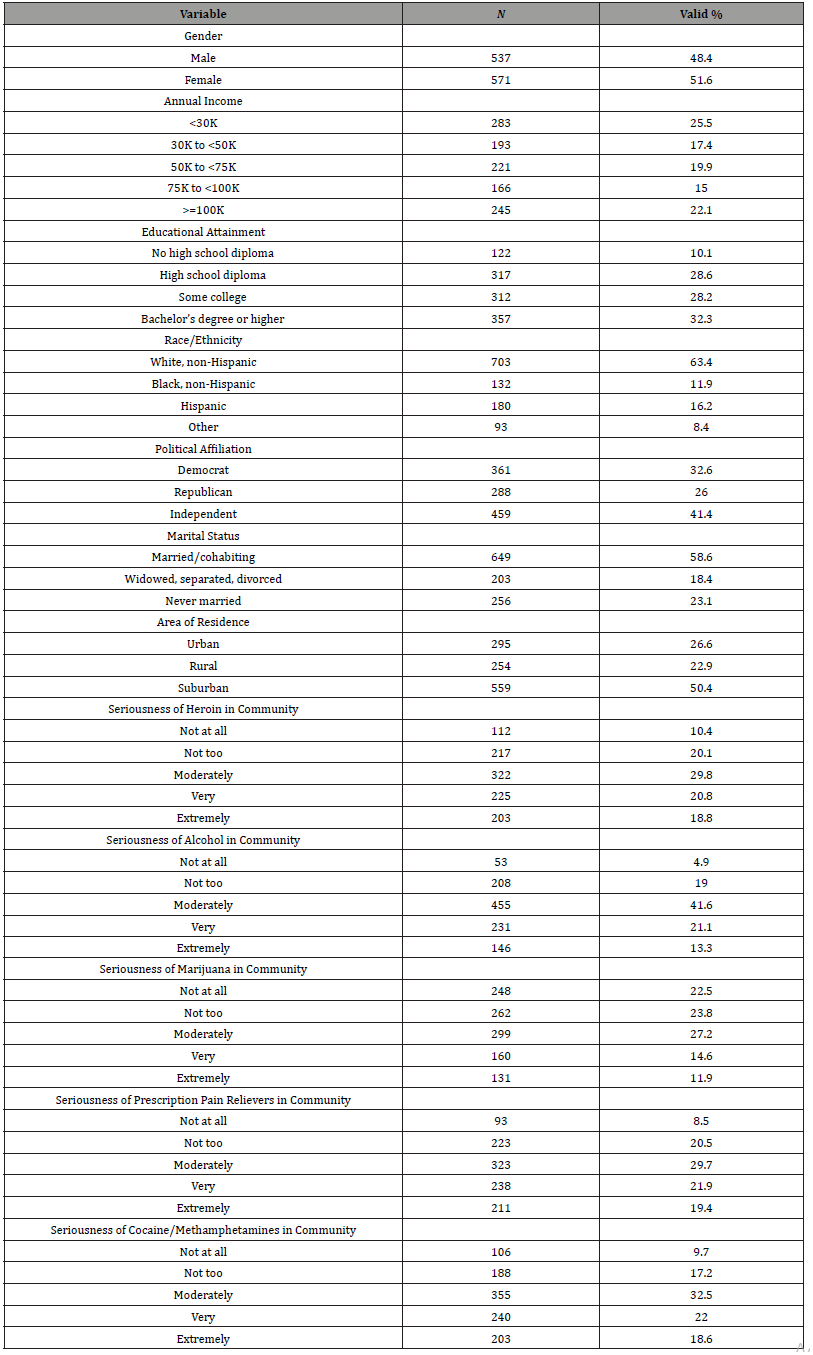
We conducted a binary logistic regression analysis of participants’ assessment of how involved their communities were, using the different approaches in the fight against the opioid epidemic, controlling for individual and community level factors in (Tables 2 to 8). Model 1 answered Aim 1: Examine factors associated with views on how community has been engaging in the fight against the opioid epidemic using different strategies. Model 2 investigated Aim 2: The association between community level of substance use and views on community engagement in the fight to control the opioid epidemic, given other factors associated with the opioid problem.
Model 1, (Table 2), shows that while Republicans compared to Independents were about 2.7 times more likely to agree that the community was doing enough or too much to make substance use treatment programs more affordable and accessible, people who lived in rural areas were about 43% less likely to agree compared to their counterparts in suburbs. Also, high school graduates and respondents with some colleges were about 3 times more likely to agree that their communities were doing much or too much to make substance use treatment programs more affordable and accessible, relative to their counterparts with no high school degree. Those with a college degree were almost 2 times more likely (odds ratio=1.87) to agree. Model 2 adds the community-level variables. The results are similar to those in Model 1. This means that even with the introduction of the additional variables that assess levels of substance exposure in the community in Model 2, the effects of residence and political affiliations are the same. Additionally, people whose communities had serious problem with prescription pain relievers such as OxyContin, Percocet, or Vicodin use and those with alcohol use issue were respectively 27% and 21% less likely to agree that the community was doing much or too much to make substance use treatment programs more affordable and accessible.
Table 2:Regression Results for Making Treatment Programs Affordable.
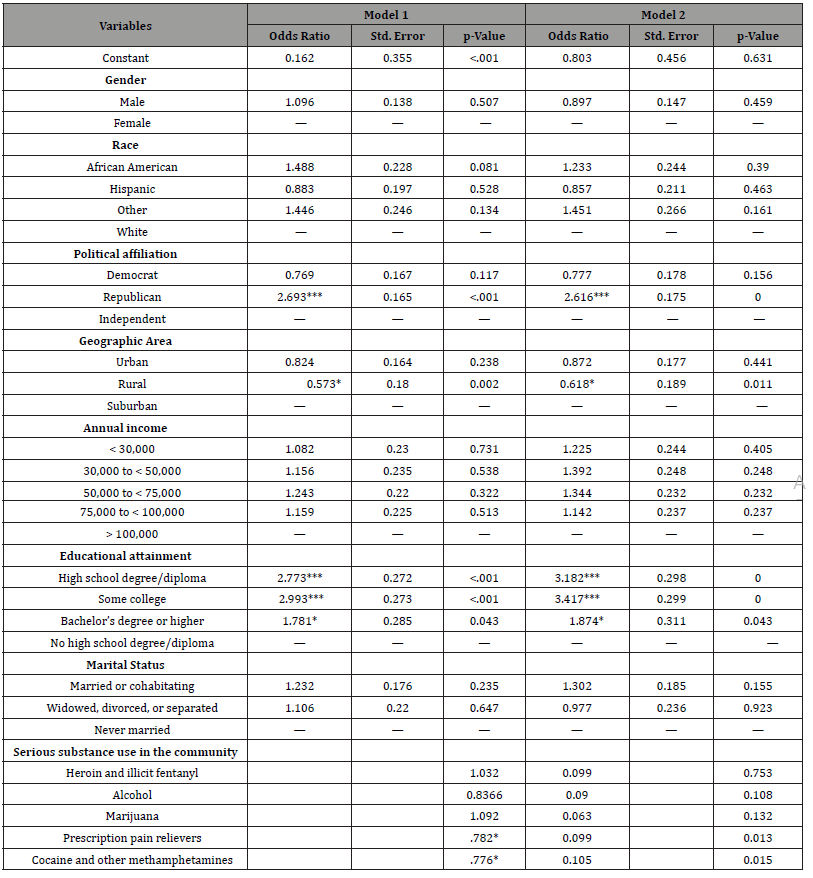
* p < .05. ** p < .01 *** p < .001
(Table 3), Model 1, shows that men were 1.3 times and Republicans were 1.8 times more likely to agree that their communities were doing enough or too much to educate doctors and dentists on the risks of prescribing opioid pain relievers compared to women and Independents, respectively. Also, people who were widowed, divorced, or separated were 1.7 times more likely to agree compared to never married. However, people who made less than $30,000, those who made $50,000 to less than $75,000, and participants who made $75,000 to less than $100,000 were 51%, 36%, and 35%, respectively, were less likely to agree relative to those who earned more than $100,000 per year. When the community variables were added in Model 2, no significant difference is revealed among income groups $50,000 and above. Only people who made less than $30,000 a year significantly agreed. It appears that respondents with less than $30,000 expect more public action to deal with the impact of opioid in their communities given the presence of other substances in the communities. Higher income earners probably believe less in public action. Whatever was being done in their communities, they considered it to be adequate. Also, people in communities where prescription pain reliever use was a serious problem were also 32% less likely to agree.
Table 3:Regression Results for Educating Doctors and Dentists

* p < .05. ** p < .01 *** p < .001
Results on the views of particpants with regard to improving treatment for substance use in(Table 4), Model 1, shows again that Republicans were 3.6 times likely to agree that their communities were doing enough or too much to improve treatment for substance use compared to Independents. While rural residents were 49% and urban residents were 36% less likely to agree compared to their counterparts who live in suburbs. People with a bachelor’s degree or higher were 55% less likely to agree. Adding the community variables in Model 2, we see some slight changes in the significance of the variables discussed in Model 1. For instance, rural residents were now only 45% less likely to agree that their communities were doing enough or too much to improve treatment for substance use compared to Independents. Living in communities with serious alcohol problems reduces the odds of agreeing by 30%. Also, people who live in communities where prescription pain relievers were a serious problem were 21% less likely to agree.
Table 4:Regression Results for Improving Treatment for Substance Use
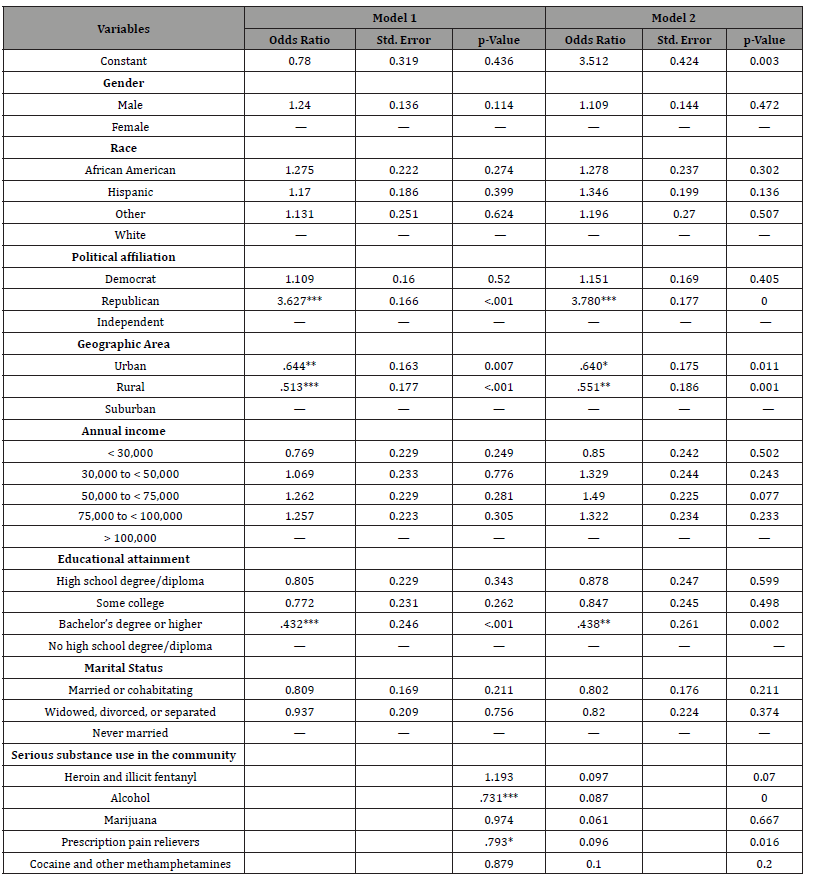
* p < .05. ** p < .01 *** p < .001
(Table 5), Model 1, presents results for respondents’ views on educating the public and students. Rural residence (odds ratio=0.580), having some college education (odds ratio=0.608) and having at least a bachelor’s degree (odds ratio=0.349) decrease the likelihood to agree that community was doing enough or too much to educate the public and students. Also, Republicans were 1.8 times more likely to agree that their communities were doing enough or too much to educate the public and students compared to Independents. The introduction of the community variables in Model 2 only slightly changes the odds ratio but they are approximately = 2. However, now, African Americans compared to Whites (odds ratio =0.583), and respondents living in areas with serious prescription pain reliever issue (odds ratio=0.694) did not agree that their communities were doing enough or too much to educate the public and students. The significance of race in Model 2 may signify that African Americans may prefer educating the public and students about substance use as an important strategy to fight the opioid crisis.
Table 5:Regression Results for Educating the Public and Students
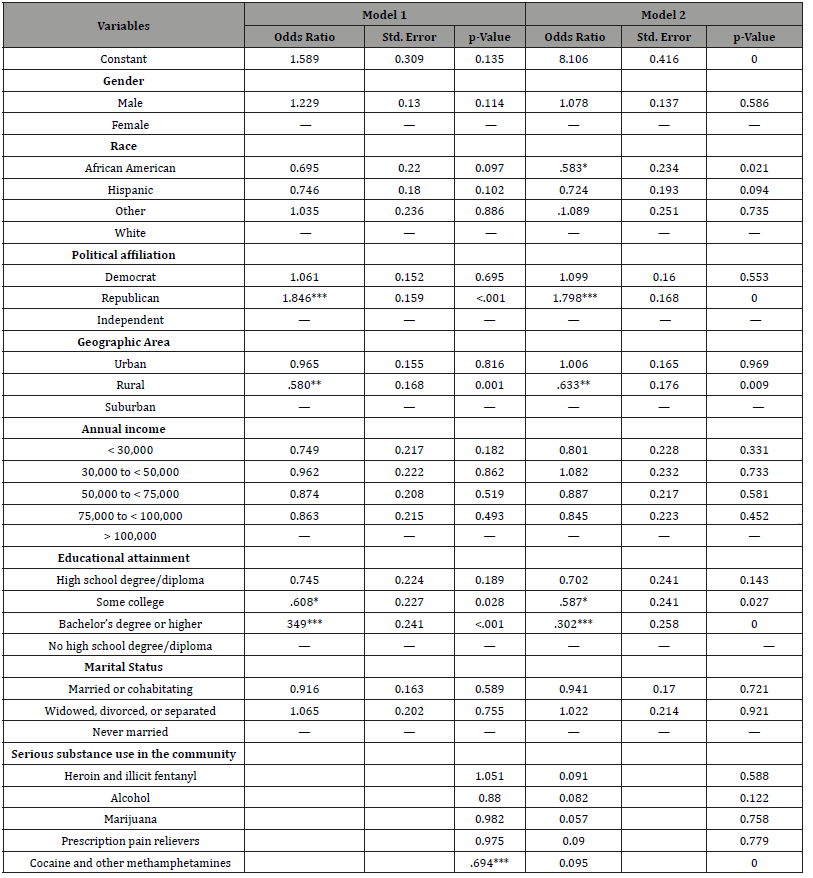
* p < .05. ** p < .01 *** p < .001
Results in (Table 6), Model 1, indicate that study participants in rural areas compared to those who lived in suburbs (odds ratio=0.479) were less likely to agree that the community has done enough or too much to crack down on drug dealers. However, respondents with at most a high school degree or diploma were 1.9 times more likely to agree that their communities have done enough or too much to crack down on drug dealers. Adding the community variables in Model 2 shows that people whose community have serious problems with heroin and illicit fentanyl (odds ratio=0.833), cocaine and methamphetamines (odds ratio= 0.643) were less likely to agree that the community has done enough or too much to crack down on drug dealers.
Table 6:Regression Results for Cracking Down on Drug Dealers

* p < .05. ** p < .01 *** p < .001
In (Table 7), Model 1, rural residents (odds ratio = 0.499) were less likely to agree that the community has done enough or too much to crack down on drug users compared to their suburban counterparts. Adding the community-level variables in Model 2 there is a small (4%) reduction in the odds of rural residents disagreeing that the community has done enough or too much to crack down on drug users compared to their suburban counterparts. Having marijuana and cocaine as serious problems in the community reduced the odds of agreeing that the community has done more or too much to crack down on drug users, respectively, by 24% and 34%.
Table 7:Regression Results for Cracking Down on Drug Users
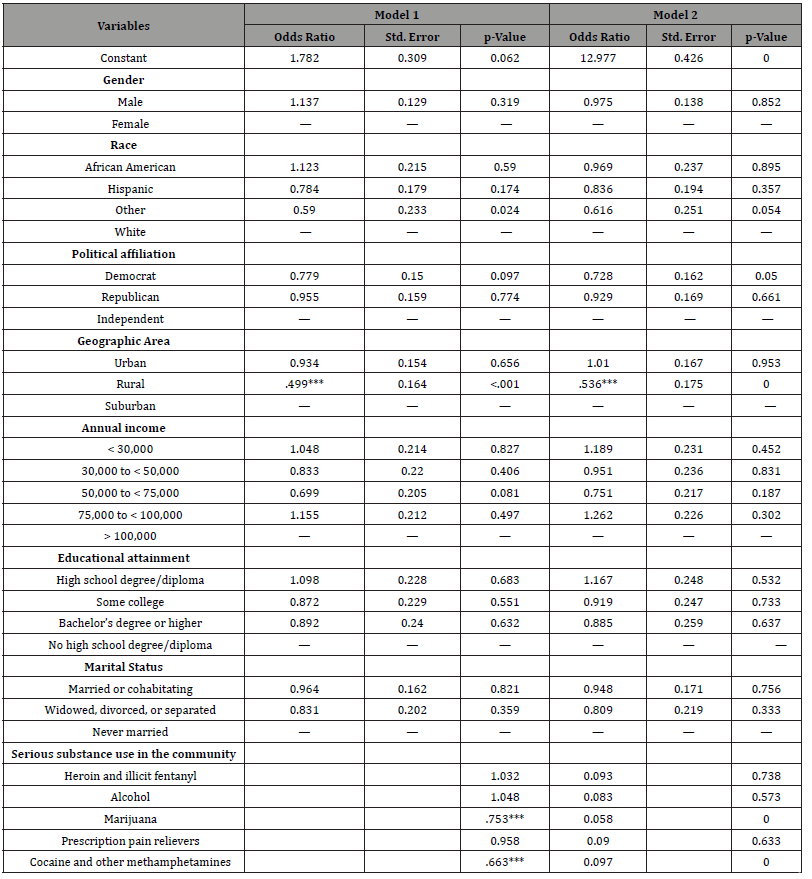
* p < .05. ** p < .01 *** p < .001
Model 1 in (Table 8) show that compared to Independents, Republicans were 2.2 times more likely to agree that the community has done enough or too much to reduce stigma and discrimination toward people with opioid and heroine addiction. However, rural residents were 45% less likely to agree relative to people in suburbs. Model 2 adds community variables. People who earned between $30,000 and less than $50,000, were 1.8 times more likely to agree that the community has done more or too much compared to those who earned over $100,000. Also, communities where alcohol is a serious substance use problem were 18% less likely to agree that the community has done enough or too much to reduce stigma and discrimination toward people with opioid and heroine addiction.
Table 8:Regression Results for Reducing Stigma
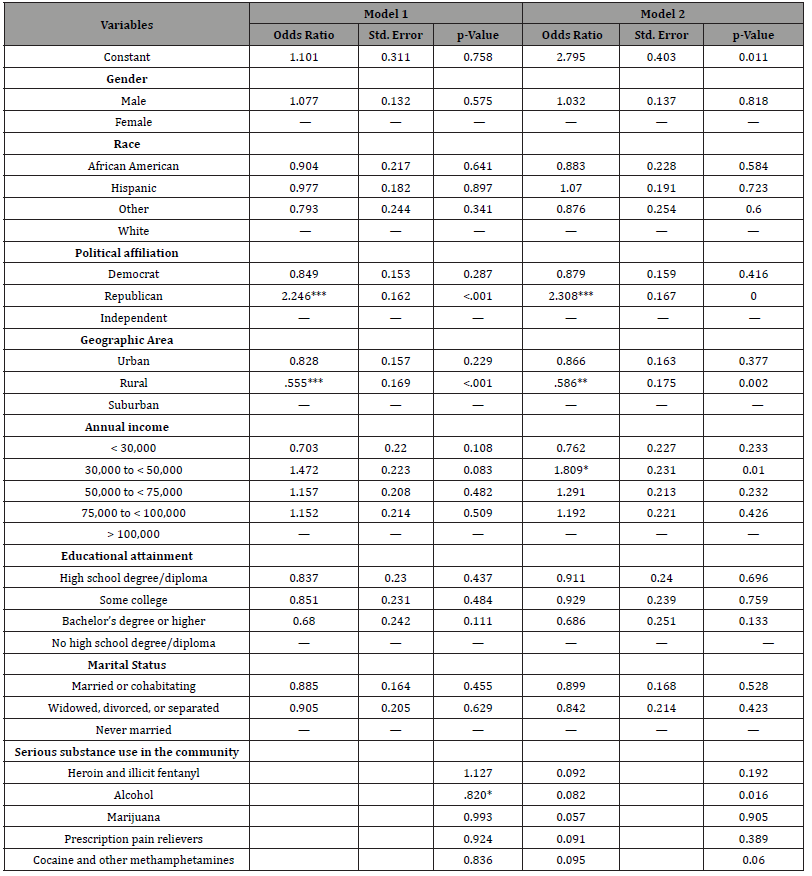
* p < .05. ** p < .01 *** p < .001
Discussion
This article has examined factors that explain community members’ views on their community engagement in the fight against the opioid crisis. The results show the complexity and the multifaceted nature of the opioid crisis. While different factors significantly explain the assessments of community members depending on the strategy being used, some factors consistently significantly explain their views regardless of the strategy. For instance, except for the two strategies ‘cracking down on drug dealers’ and ‘cracking down on drug users’ as policies to control for opioid epidemic, Republicans were consistently more likely to agree that their communities were doing enough or too much on the other 5 strategies: 1. Making treatment programs affordable; 2. Educating doctors and dentists on risks of prescribing opioid pain relievers; 3. Improving treatment for substance use; 4. Reducing stigma and discrimination towards people with opiod addiction; and 5. Educating the public and students to prevent substance use, compared to Independents. As reported in other studies [29,30], partisanship shapes policies including treatment-related policies. Regarding the opioid crisis, partisan views also were found, for example, in the STAT-Havard Chan study [31], whereby 45% of Democrats agreed that the government spending on treatment program for people with opioid or heroin addiction was low compared to 37% of Republicans. [32], even, reported an increased gap between Democrats (52%) who showed support for more federal government spending to fight the opioid epidemic relative to Republicans (38%). [19] also reported partisanship in the support for expansion of treatment services in Virginia whereby Republicans showed opposition to expanding recovery housing in the community. In fact, the partisanship of policy makers was blamed by [33] as one of the reasons for the spread of the opioid crisis in the United States.
Apart from educating doctors and dentists on risks of prescribing opioid pain relievers, compared to suburban residents, rural residents were less likely to agree that their communities have done enough to control the opioid crisis relative to suburban residents on all the other 6 strategies: 1. Make substance use treatment programs more affordable and accessible; 2. Educate the public and students to prevent substance use; 3. Improve treatment for substance use; 4. Crack down on drug users; 5. Crack down on drug dealers; 6. Reduce stigma and discrimination towards people with opiod addiction. This may be explained by the fact that rural areas were initially hit the hardest by the opioid crisis and have become more vulnerable to the epidemic [34,35,24]. Residents in rural areas may feel overwhelmed by the crisis and do not see any way out, thus, their negative responses to how their communities had fared to combact the opioid epidemic. Additionally, as indicated by [36], these rural areas have mostly White residents who have not experienced any of the past drug crises. They also tend to be conservatives. Thus, the opioid epidemic becomes a conundrum for them as Republicans generally support less governmental interventions. As documented by [29], these different partisan positions of the rural residents in our study may align with their self-interests rather than their partisan beliefs, leading to their cross-pressures of policy preferences with regard to ways their communities have handled the opioid crisis. Both their personal experiences and self-interests may have attenuated their partisanship beliefs. Hence, they did not think it is a matter of personal responsibility to do more to mitigate the opioid crisis.
Education and income have mixed effects depending on strategies. For example, compared to respondents with no high school degree, study participants who had at least a high school degree or diploma believed that their communities were doing enough or too much to make treatment programs affordable. Also, respondents with high school degree or diploma thought their communities were doing enough or too much to crack down on drug dealers relative to those with no high school degree or diploma.
However, those with a bachelor’s degree or higher believed that their communities were not doing enough or too much to improve treatment for substance use as well as educating the public and students about opioids compared to those with no high school degree or diploma. Also, compared to people who earned at least $100,000, people who earned less than $30,000 and those who earned $50,000 to less than $100,000 thought their communities were not doing enough to educate physicians and dentists about use of opioids as pain relievers. However, people who made between $30,000 to less than $50,000 thought their communities were doing enough or too much reducing stigma toward people with opioid addition. While educational attainment has been shown to be a positive determinant of support for treatment expansion in the community and a basis for better understanding of addiction and treatment needs [19], the results in this current paper are not uniform. This may be explained by the different strategies used.
Race did not have a significant effect except for African American respondents who thought that their communities were not doing enough to educate the public and students about substance use prevention. Also, respondents who were either married, divorced, or separated did believe that their communities were doing enough or too much to educate physicians and dentists.
At least one of the community exposures to substance use variables significantly reduced the odds of community members agreeing that their communities have been doing enough or too much regarding each of the strategies. While this should be expected, the strategies for which respondents significantly identified two types of substances being a serious matter in their communities were treatment-related and punitive such as: 1. Make treatment programs for substance use more affordable, 2. Improve treatment for substance use, 3. Cracking down on drug dealers, and 4. Cracking down on drug users. For the punitive strategies, respondents believed that marijuana, heroine and illicit fentanyl, and cocaine and other methamphetamines were serious substance use in the community. Alcohol, prescription pain relievers, and cocaine and other methamphetamines were identified as being serious in the community for the treatment-related strategies.
While important findings are noted in the paper, a few limitations need to be specified. Data are cross sectional and cannot infer causation. Data are self-reports and may have issues with recall and social desirability.
Conclusion
Several important points could be made about the findings in this study. First, there are differences in the views of how communities have tackled the opioid crisis along political lines indicating that political ideologies and beliefs may be clouding judgment of what is really going on in the communities. Hence, intentional and targeted messages should be created to sensibilize Americans about the real impacts of the opioid crisis on communities, what is needed to seriously combat the crisis, and ways to notably tackle the epidemic. As public opinion partly influences success or failure of government response to the opioid epidemic [29], the importance for communities to come together and advocate for meaningful changes will be one way to help solve this crisis. Second, rural residents, while they tend to be Whites and conservatives [37], their opinions reflect their self-interests more so than their conservative ideologies of personal responsibility and less of government intervention. Additionally, their contact with this social problem, opioid misuse, seems to affect their political participation and policy attitudes as reported by [29]. Thus, stakeholders may use these facts for policy support and leverage. Third, understandably, community exposure to substance use seems to be an important factor of concern regardless of the strategies used to combat the crisis. Ideally, it will be great if communities were not exposed to substances and their use. However, the realities are dire. Alcohol and marijuana are by far the most commonly abused substances among teen and young adult Americans [38]. Hence, substance abuse prevention programs should be at the individual, familial, community, and social levels. These programs should teach children and their families not only about substance use prevention but also ways to detect substance use among children. Also, there should be programs in the communities where both parents and children could readily seek help in case of substance use. Additionally, stigma related to substance abuse and mental health should be combatted for people to freely seek help. The present study adds to the body of literature on the opioid crisis and communities’ assessment of what has been done to help stop the crisis. Results indicate that different opinions are shared depending on Americans’ political, residential, and social characteristics as well as the community exposure to substance use.
Acknowledgement
Declaration of interest statement
References
- (2017) United Nations Office on Drugs and Crime. World Drug Report.
- (2021) Centers for Disease Control and Prevention Understanding the Epidemic.
- Woolf SH, Schoomaker H (2019) Life expectancy and mortality rates in the United States, 1959-2017. JAMA Network, 322(20): 1996-2016.
- Altekruse SF, Cosgrove CM, Altekruse WC, Jenkins RA, BlancoC (2020) Socioeconomic risk factors for fatal opioid overdoses in the United States: Findings from the Mortality Disparities in American Communities Study (MDAC). PLoS ONE 15(1): e0227966.
- El-Bassel N, Gilbert L, Hunt T, Wu E, Oga EA et al. (2021) Using community engagement to implement evidence-based practices for opioid use disorder: a data-driven paradigm & systems science approach. Drug and Alcohol Dependence 222: 108675.
- Kunins HV (2020) Structural racism and the opioid overdose epidemic: the need for antiracist public health practice. Journal of Public Health Management and Practice 26 (3): 201-205.
- Enns B, Krebs E, Thomson T, Dale L M, Min JE, et al. (2021) Opioid analgesic prescribing for opioid-naïve individuals prior to identification of opioid use disorder in British Columbia, Canada. Addiction 116(12): 3422-3432.
- Cyril S, Smith BJ, Possamai-Inesedy A, Renzaho AM (2015) Exploring the role of community engagement in improving the health of disadvantaged populations: a systematic review. Global Health Action 8(1): 29842.
- Chung K, Lounsbury DW (2006) The role of power, process, and relationships in participatory research for statewide HIV/AIDS programming. Social Science & Medicine 63(8): 2129-2140.
- Trickett EJ, Beehler S, Deutsch C, Green LW, Hawe P, etal. (2011) Advancing the science of community-level interventions. American Journal of Public Health 101(8): 1410-1419.
- Palombi L, Olivarez M, Bennett L, Hawthorne A N (2019) Community forums to address the opioid crisis: An effective grassroots approach to rural community engagement. Substance Abuse: Research and Treatment 13: 1178221819827595.
- Sprague L, Afifi R, Ayala G, El-Nasoor ML (2019) Participatory praxis as an imperative for health-related stigma research. BMC Medicine 17(1): 1-8.
- Pickett JT (2019) Public opinion and criminal justice policy: Theory and research. Annual Review of Criminology 2(1): 405-428.
- Sobotka TC, Stewart SA (2020) Stereotyping and the opioid epidemic: A conjoint analysis. Social Science & Medicine 255: 113018.
- Baumgartner FR, Jones BD (2015) The politics of information: Problem definition and the course of public policy in America. University of Chicago Press, USA.
- Sun D, Graham A, Feldmeyer B, CullenFT, Kulig TC (2022) Public opinion about America’s opioid crisis: Severity, sources, and solutions in context. Deviant Behavior pp. 567-590
- Barry CL, McGinty EE, Pescosolido BA, Goldman HH (2014) Stigma, discrimination, treatment effectiveness, and policy: public views about drug addiction and mental illness. Psychiatric Services 65(10): 1269-1272.
- Burstein P. (2003) The Impact of Public Opinion on Public Policy: A Review and an Agenda. Political Research Quarterly 56(1): 29–40.
- Cook AK, Worcman N (2019) Confronting the opioid epidemic: public opinion toward the expansion of treatment services in Virginia. Health & Justice 7(1): 1-12.
- Barry DT, Cutter CJ, Beitel M, Kerns RD, Liong C, Schottenfeld RS (2016) Psychiatric disorders among patients seeking treatment for co-occurring chronic pain and opioid use disorder. The Journal of Clinical Psychiatry 77(10): 1413-1419.
- Ford JA, Rigg KK (2015) Racial/ethnic differences in factors that place adolescents at risk for prescription opioid misuse. Prevention Science 16(5): 633-641.
- Holtfreter K, Reisig MD, O’Neal EN (2015) Prescription drug misuse in late adulthood: An empirical examination of competing explanations. Journal of Drug 45(4): 351-367.
- Hartig H, Doherty C (2018) More in US See Drug Addiction, College Affordability, and Sexism as ‘Very Big’National Problems. Pew Research Center.
- Keyes KM, Cerdá M, Brady JE, Havens JR, Galea S (2014) Understanding the rural-urban differences in nonmedical prescription opioid use and abuse in the United States. American Journal of Public Health 104(2): e52-e59.
- Collier L (2018) Young victims of the opioid crisis. Monitor on Psychology 49(1): 18.
- Blendon RJ, Benson JM (2018) The public and the opioid-abuse epidemic. New England Journal of Medicine 378: 407-411.
- Gramlich J (2018) As fatal overdoses rise, many Americans see drug addiction as a major problem in their community. Retrieved from: Many in US say drug addiction is a major problem in their community | Pew Research Center
- AP-NORC. 2019. Pharmaceutical companies and drug users most often blamed for opioid crisis. NORC.
- de Benedictis-Kessner J, Hankinson M (2019) Concentrated burdens: How self-interest and partisanship shape opinion on opioid treatment policy. American Political Science Review 113(4): 1078-1084.
- Caughey D, Warshaw C, XuY. (2017) Incremental democracy: The policy effects of partisan control of state government. The Journal of Politics, 79(4): 1342-1358.
- Harvard TH (2016) Chan School of Public Health. New national poll: Cancer is America's top health concern.
- Johnston T (2017) Americans think opioid addiction is a crisis. They're not sure federal dollars will solve it. The Washington Post.
- Laugesen M, Patashnik EM (2020) Framing, governance, and partisanship: Putting politics front and center in the opioid epidemic. Journal of Health Politics, Policy and Law 45(2):365-372.
- Rigg KK, Monnat SM, Chavez MN (2018) Opioid-related mortality in rural America: geographic heterogeneity and intervention strategies. International Journal of Drug Policy 57: 119-129.
- Ghertner R, Groves L (2018) The opioid crisis and economic opportunity: geographic and economic trends. ASPE Research Brief, 1-22.
- Jalal H, Buchanich JM, Roberts MS, Balmert LC, Zhang K, etal. (2018) Changing dynamics of the drug overdose epidemic in the United States from 1979 through 2016. Science 361(6408): eaau1184.
- Parker K, Horowitz JM, Brown A, Fry R, Cohn D, Igielnik I (2018) Urban, suburban and rural residents' views on social and political issues. Pew Research Center.
- (2023) U.S. Department of Health and Human Services. SAMHSA announces national survey on drug use and health (NSDUH) results detailing mental illness and substance use levels in 2012.
- Johanson CE, Arfken CL, di Menza S, Schuster CR (2012) Diversion and abuse of buprenorphine: findings from national surveys of treatment patients and physicians. Drug and Alcohol Dependence 120(1-3): 190-195.
- Yaugher AC, Bench SW, Meyers, KJ, Voss MW (2020) How psychologists can impact the opioid epidemic. Professional Psychology: Research and Practice 51(1): 85.
-
Ami R Moore*, Joshua Castleberry, Skyla Kraal and Foster Amey. The Fight Against Opioids Epidemic: Americans’ Views on Community Involvement. Annal of Pub Health & Epidemiol. 2(3): 2024. APHE.MS.ID.000539.
-
Global warming; climate change; lac +ve and lac-ve mutants; microbiota; lactococcus lactis var. lactis; tornados; tsunami; hurricanes; plasmids; probiotics; public health; iris publishers; iris publisher’s group
-

This work is licensed under a Creative Commons Attribution-NonCommercial 4.0 International License.
- Abstract
- Introduction
- The effect of global warming-climate change on inducing unfavorable mutations in both the beneficial as well as harmful micro-organisms, including viruses, causing severe endemics, epidemics, and pandemics, proven through laboratory research experiments
- Materials and Methods
- Results and Discussion
- Conclusion of Experiment
- The Effect of Global Warming - Climate Change on Human Health
- The Adverse Effect of Global Warming- Climate Change on Agricultural Crops and Food Production
- The Effect of Global Warming- Climate Change on Inducing Adverse Natural Calamities, Around the World
- Possible Ways, Means and Remedial Measures to Control Global Warming- Climate Change to Protect Humanity
- Disclosure
- Acknowledgement
- Conflict of Interest
- References






